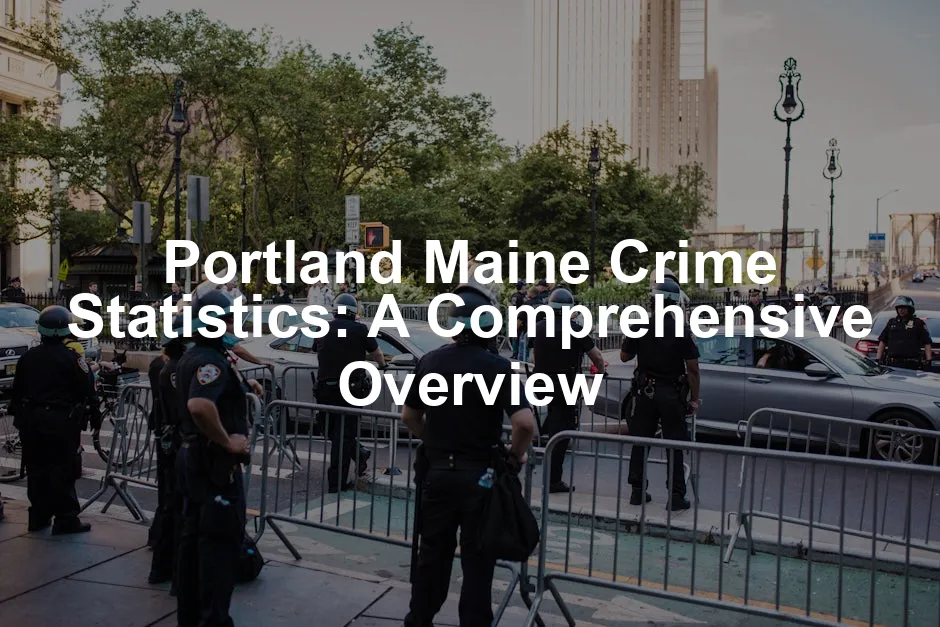Introduction
Portland, Maine, is a charming coastal city known for its stunning waterfront, historic architecture, and vibrant arts scene. Nestled in the southeastern corner of the state, it boasts a population of around 66,000 residents, making it Maine’s largest city. Portland is not just a feast for the eyes; it’s a melting pot of culture and community, attracting tourists and new residents alike.
Understanding crime statistics in Portland is crucial for various stakeholders. Residents want to feel secure in their neighborhoods. Potential movers are keen on knowing if Portland is a safe place to call home. Meanwhile, local businesses often rely on these statistics to gauge safety for their operations and customers.
This article aims to provide a thorough examination of crime statistics in Portland. We will compare these figures with national averages and the statistics of nearby cities. The goal is to equip readers with valuable insights into the city’s safety landscape. Whether you’re a curious local or considering a move, understanding these statistics can help you make informed decisions.
Understanding Crime in Portland
The Crime Rate Overview
Portland’s crime statistics present a mixed bag. The city’s violent crime rate stands at 21.1, slightly lower than the national average of 22.7. This suggests that, when it comes to violent offenses, Portland is somewhat safer than many other U.S. cities. Residents can breathe a bit easier knowing that violent crime isn’t a rampant issue.
However, property crime tells a different story. Portland’s property crime rate is 44.8, which is significantly higher than the national average of 35.4. This indicates that while residents might not need to worry excessively about violent crime, they should remain vigilant regarding property safety.
It’s important to note that Portland lacks specific FBI crime statistics. Instead, we can draw parallels from data in nearby cities, providing a comparative backdrop to understand local crime trends better.

Crime Ratings
According to various sources, Portland’s crime ratings reflect these mixed results. AreaVibes gives Portland a crime grade of B+, indicating that the total crime rate is approximately 20% lower than the national average. This is promising news for those living in or moving to the area.
On the other hand, Niche rates Portland with a C+, suggesting that there are areas of concern, particularly related to property crime. The city’s crime ratings highlight the necessity for residents to be aware of their surroundings and take appropriate precautions.
In summary, while Portland has a relatively low violent crime rate, property crime remains a significant concern. It’s essential for residents, potential movers, and local businesses to stay informed about these trends. Understanding both the positive and negative aspects of crime statistics can foster a safer community for everyone involved.

Detailed Crime Statistics
Violent Crimes
Portland, Maine, experiences a variety of violent crimes, albeit at rates lower than the national average. Let’s break down the statistics by category:
- Murder: Portland reported 5 murders in 2022, equating to a rate of 7.3 per 100,000 residents. Although tragic, this figure is notably lower than the national average of 6.3.
- Rape: The city recorded 31 incidents of rape, resulting in a rate of 45.5 per 100,000 residents. This is higher than the national average of 40.0, signaling a need for increased community awareness and safety measures.
- Robbery: In 2022, Portland witnessed 17 robberies, translating to a rate of 24.9 per 100,000. Comparatively, the national average stands at 66.1, indicating that Portland’s residents face significantly less risk of robbery than in many other U.S. cities.
- Assault: Assaults accounted for 73 reported incidents, yielding a rate of 107.0 per 100,000 residents. This figure is lower than the national average of 268.2, which paints a picture of relative safety regarding this type of crime.
Overall, while Portland is not entirely immune to violent crime, the statistics suggest a city that is generally safer than many others across the U.S.

Property Crimes
When it comes to property crimes, Portland shows a different trend, with numbers that warrant attention:
- Burglary: The city recorded 35 burglaries, leading to a burglary rate of 51.3 per 100,000 residents. This is significantly lower than the national average of 269.8, indicating that home break-ins are relatively rare.
- Larceny: Larceny thefts dominated Portland’s property crime landscape, with 1,018 incidents reported, resulting in a rate of 1,492.7 per 100,000. This figure is notably higher than the national average of 1,401.9, suggesting that residents should remain vigilant. If you’re looking for ways to secure your belongings, consider investing in a security camera to keep an eye on your property.
- Auto Theft: Auto thefts numbered 96, resulting in a rate of 140.8 per 100,000 residents. This is lower than the national average of 282.7, which is good news for vehicle owners in the area.
In summary, while property crime rates in Portland are higher than the national average, particularly for larceny, the overall picture remains relatively optimistic when compared to other cities.

Year-over-Year Trends
Analyzing year-over-year trends provides valuable context for understanding crime in Portland. Recent data indicates a general decline in crime rates across both violent and property crime categories over the past few years.
From 2021 to 2022, total crime decreased by 5.7%, with violent crime dropping by 17.1%. Notably, property crime saw a reduction of 4.3% during the same period. This downward trend is encouraging, especially as many urban areas face rising crime rates.
To illustrate these trends more clearly, here’s a glimpse of historical data comparing violent crime rates:
| Year | Violent Crime Rate (per 100,000) | Property Crime Rate (per 100,000) |
|---|---|---|
| 2020 | 137.6 | 122.0 |
| 2021 | 126.1 | 106.0 |
| 2022 | 185.0 | 1,149 |
This table showcases the fluctuation of crime rates, highlighting Portland’s ongoing efforts to enhance community safety. Overall, the data suggests a positive trend toward making Portland a safer environment for its residents.
As we continue to monitor Portland’s crime statistics, it becomes increasingly clear that understanding these figures is essential for fostering a sense of community safety and awareness among residents and potential movers alike.

Neighborhood Crime Analysis
Overview of Portland Neighborhoods
Portland, Maine, features a collection of neighborhoods, each with its own unique vibe and, yes, crime rates. Understanding these variations helps residents and potential movers make informed decisions about where to live.
In the safer corners of Portland, neighborhoods like Rosemont and Deering Center shine like gems. Rosemont is known for its friendly community and picturesque streets, making it an appealing choice for families. Deering Center offers a tranquil atmosphere with parks and local shops, providing a sense of security that residents appreciate.
On the flip side, areas such as Downtown and West Bayside present higher crime rates. Downtown, while vibrant and bustling, has reported more property crimes, including theft and burglary. West Bayside, similarly, has faced challenges with property crimes, leading residents to be more cautious.
Visual representations of these crime rates can be invaluable. Neighborhood maps and crime charts illustrate the disparities, showcasing where residents can feel safer and where they might want to stay alert. For example, a map highlighting the number of reported crimes per neighborhood can visually depict the safest and riskiest areas. This kind of data empowers residents with knowledge, allowing them to make decisions based on facts rather than hearsay.

Comparison with Nearby Cities
When comparing crime rates, it’s crucial to look beyond Portland. Nearby cities like South Portland and Westbrook serve as useful benchmarks.
South Portland, with a population of around 27,000, has a violent crime rate of 186.9 per 100,000 residents, which is considerably higher than Portland’s 21.1. In terms of property crime, South Portland also sees a spike, reporting rates of 2,191.9 per 100,000.
Westbrook, another close neighbor, shows a violent crime rate of 177.4 and a property crime rate of 1,382.7. It’s clear Portland stands out with a lower violent crime rate, suggesting that while property crime is a concern, violent crime remains relatively low.
To summarize, here’s a quick comparison table that encapsulates these statistics:
| City | Violent Crime Rate (per 100k) | Property Crime Rate (per 100k) |
|---|---|---|
| Portland, ME | 21.1 | 44.8 |
| South Portland, ME | 186.9 | 2,191.9 |
| Westbrook, ME | 177.4 | 1,382.7 |
This snapshot of crime statistics across nearby cities provides valuable context for understanding Portland’s crime landscape. Residents can better gauge their safety by comparing these figures and making educated decisions about their neighborhoods.
Portland’s overall crime landscape may have its challenges, particularly with property crimes, but when stacked against its neighbors, it still offers a relatively safe haven for its residents.

Factors Influencing Crime Rates
Economic and Social Influences
Crime rates in Portland, Maine, don’t exist in a vacuum. They’re influenced by various economic and social factors. For starters, economic conditions can directly impact crime. Areas with high poverty rates often see spikes in criminal activity. In Portland, the poverty rate sits at 13.9%, which is lower than the national average of 15.1%.
But what does that really mean? When people struggle financially, they might turn to crime out of desperation. In contrast, economic stability tends to correlate with lower crime rates. So, a thriving job market can help keep the crime rate in check.
Education also plays a crucial role in shaping crime statistics. Portland boasts an impressive 88.7% high school graduation rate, surpassing the national average of 83%. Higher educational attainment often leads to better job opportunities, reducing the likelihood of individuals resorting to crime. Educated individuals tend to make informed decisions, contributing positively to the community.
Now, let’s not forget about the social fabric of the city. Strong community ties can foster safety and security. Neighborhoods with engaged residents often report lower crime rates. People watching out for one another can create a safer environment, making crime less appealing.

Law Enforcement and Community Safety
When it comes to law enforcement, Portland stands out with robust resources. The Portland Police Department employs 218 personnel, which translates to about 3.28 officers per 1,000 residents. This exceeds the national average of 3.25 officers per 1,000 residents. A well-staffed police force can deter crime and enhance community safety.
But how do residents feel about their safety? According to local surveys, perceptions play a big part in understanding crime in Portland. A recent AreaVibes survey found that 60% of residents feel safe walking alone at night, while 40% expressed concerns about their safety. These insights reveal a community that is generally confident in its law enforcement but still acknowledges areas for improvement.
Moreover, the effectiveness of law enforcement is crucial. Residents reported varying levels of satisfaction with police presence and response times. Some feel police are quick to respond but not always visible. Others think the police are visible, yet response times can lag. This feedback highlights the need for ongoing dialogue between law enforcement and the community.
Ensuring safety is a collaborative effort. Encouraging community programs can enhance relationships between residents and police, fostering trust and cooperation. By working together, Portland can continue to improve its safety landscape, addressing concerns and building a stronger, more connected community.

Impact of Recent Events
The COVID-19 pandemic has left its mark on crime rates across the nation, and Portland, Maine, is no exception. During the height of the pandemic, many cities experienced shifts in crime patterns. As people stayed indoors, some crime rates dipped, while others, particularly property crimes, saw fluctuations due to economic strain.
In Portland, the overall crime rate decreased by 5.7% from 2021 to 2022. This decrease may reflect a growing sense of community responsibility as residents looked out for one another during tough times. However, property crime remained a concern, particularly as the housing market surged, attracting newcomers willing to pay top dollar for real estate. This influx has led to some tensions, as longtime residents might feel the pinch of gentrification, which can potentially lead to crime.
Moreover, as businesses closed or reduced hours, the streets became quieter. This quietness often leads to a perception of safety, even though it can mask underlying issues. Residents may feel safer walking alone at night, but the reality is that property crimes, such as larceny, continue to pose threats.
The community’s response to these challenges has been a mix of resilience and adaptation. Local organizations have stepped up efforts to foster neighborhood watch programs and community policing initiatives. These efforts aim to bolster safety perceptions and improve actual safety levels.
Portland’s crime landscape is undoubtedly influenced by these recent events. As the city gradually returns to normalcy, it will be interesting to see how these dynamics evolve. Will crime rates stabilize, or will new challenges emerge as the community adjusts to post-pandemic life? Only time will tell, but one thing is clear: understanding these changes is essential for fostering a safe and vibrant Portland.

Conclusion
In summary, the crime statistics in Portland, Maine, present a complex picture. The city boasts a violent crime rate of 21.1, slightly below the national average of 22.7. This suggests that Portland is a relatively safe city regarding violent offenses. Residents can feel reassured that violent crime is not a rampant issue here.
However, property crime tells a different tale. With a property crime rate of 44.8, significantly higher than the national average of 35.4, residents should remain vigilant. While violent crime may not be a major concern, the higher property crime rates highlight the need for ongoing awareness and safety measures. If you’re looking for a gripping read on crime, check out Crime and Punishment by Fyodor Dostoevsky, a classic that dives deep into the human psyche and morality.
When compared to nearby cities, Portland stands out as a safer option. South Portland and Westbrook, for instance, report higher violent crime rates, emphasizing the relative safety of Portland. The city’s commitment to community safety, bolstered by local law enforcement and community initiatives, plays a crucial role in maintaining this safety.
As we conclude, it’s important for residents and potential movers to stay informed about crime statistics. Knowledge empowers individuals to make safer choices. For those living in Portland, taking personal safety measures can enhance overall community well-being. Whether it’s joining a neighborhood watch, attending community safety meetings, or simply being aware of surroundings, every little effort counts.
Portland is a vibrant city with many opportunities, and understanding its crime statistics is essential for fostering a safe environment. By staying informed and engaged, residents can contribute to a safer Portland for everyone.

FAQs
Is Portland, Maine, a safe city?
Portland is generally considered a safe city. The violent crime rate is 21.1, lower than the national average of 22.7. While property crime rates are higher, residents often feel a sense of community safety. Surveys indicate that about 60% of residents feel safe walking alone at night.
What are the safest neighborhoods in Portland?
Safer neighborhoods include Rosemont, Deering Center, and North Deering, where crime rates are lower. These areas are known for their friendly communities and family-oriented environments, making them ideal for those seeking a secure living space.
How does Portland’s crime rate compare to other cities in Maine?
When compared to nearby cities like South Portland and Westbrook, Portland’s crime rates are more favorable. South Portland has a violent crime rate of 186.9, while Westbrook reports 177.4. This comparison underscores Portland’s relative safety within the region.
What can residents do to improve community safety?
Residents can improve community safety by getting involved in local initiatives, like neighborhood watch programs. Staying active in community meetings and collaborating with local law enforcement can foster a sense of security. Simple actions, like maintaining good communication with neighbors, can also strengthen community ties.
Where can I find more detailed crime statistics?
For detailed crime statistics, resources like the FBI’s Uniform Crime Reporting (UCR) program and local government websites provide comprehensive data. Websites like AreaVibes and BestPlaces also offer insights into Portland’s crime landscape, allowing residents to stay informed.
Please let us know what you think about our content by leaving a comment down below!
Thank you for reading till here 🙂
For a comprehensive analysis of safety in 2023, you can check out the Fremont crime statistics.
Additionally, if you’re curious about understanding the complexities of mass incarceration, check out The New Jim Crow: Mass Incarceration in the Age of Colorblindness by Michelle Alexander, a thought-provoking read that delves into systemic issues.
All images from Pexels




